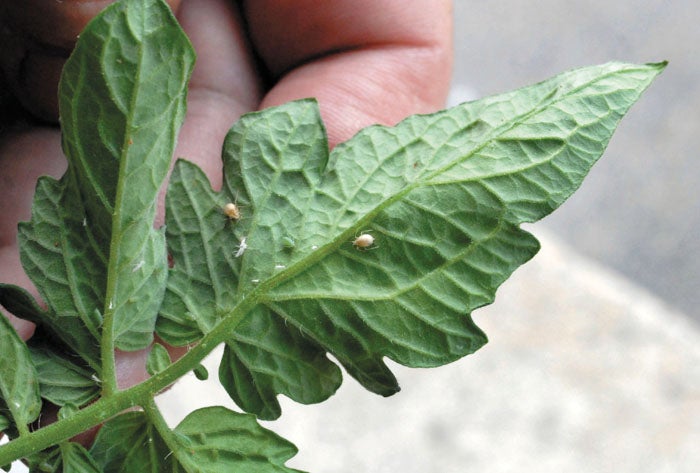Keep an eye out for aphids this fall
Published 12:00 am Sunday, September 20, 2020

- A young tomato plant leaf with several aphids. Photo by Jon C. Lakey, Salisbury Post file photo.
By Michael O. Fine
Rowan Cooperative Extension
When it comes to growing just about anything, there is one pest that rears its head time and time again; the ever-present aphid. These soft-bodied insects attack many plants and leave them weakened and prone to disease. Aphids are typically less than 1/10 of an inch and vary widely in color, ranging from white all the way through green, brown, and even black. They are often found hiding along stems or clustered in dense groups under leaves. Some may even have wings, which is a sign that the colony is about to disperse unto adjacent foliage.
As aphids spread, they vector diseases from one plant to another as the suck sugary sap from the underside of weak leaves. As aphids rob the sugars produced by the plant through photosynthesis, they excrete a sugary substance of their own, called “honeydew.” The excreted honeydew, in turn, is harvested by most species of ants.
In this symbiotic relationship the ants will move aphid populations from one host plant to another in search of plant sugars to rob.
Here are some quick tips to keep aphid populations under control:
• Check plants regularly. This one can sound like a broken record, but a weekly run- through of the plant foliage with your hand can quickly detect aphid populations on the backside of leaves. Detecting aphids in small colonies before they repopulate is key. Only during the earliest stages of an infestation, can growers realistically remove the aphids by hand.
• If the aphid population has already reached a point in which mechanical removal is unrealistic, then a blast of high-pressured water mixed with soap can blast the aphids from the underside of the leaf. If the grower has enough water pressure to dislodge the aphids, they rarely return to the same host plant.
• Neem oil has been found to have effectiveness with aphids. Again, to completely liquidate a population of aphids, continual applications will be required. Also, beware applying heavy oils to sensitive plant foliage during sunny, hot weather.
• For those looking for a holistic approach in your gardening endeavors, nothing can compare to the beneficial effects of encouraging the conservation or establishment of pollinator habitats. Within these habitats, carnivorous insects that love to devour aphids produce populations of their own.
The best habitats consist of areas adjacent to the gardens where multi-seasonal species of flowering plants grow wild or are planted intentionally by the grower. Clovers that are inter-seeded with upright, singled flowered plants like marigolds create a multi-dimensional, jungle-like canopy for insects to flourish.
Remember, model nature when designing your gardening landscape.
Hopefully these tips will help you the next time you see those tiny, soft-bodied insects on your plants. Happy gardening!
Michael O. Fine is horticulture and local food agent with the North Carolina Cooperative Extension Rowan County Center. Contact him at 704-216-8970 or
mofine@ncsu.edu.




